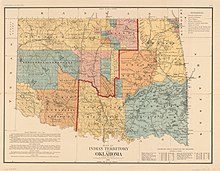
Back الإقليم الهندي Arabic Индианска територия Bulgarian Territori Indi Catalan ᎠᏂᏴᏫᏯᏍᏛᏱ CHR Indianerterritoriet Danish Indianerterritorium German Indiana Teritorio Esperanto Territorio Indio (Estados Unidos) Spanish Indiar Lurraldea Basque Intiaaniterritorio Finnish
| Indian Territory | |||||||||||
|---|---|---|---|---|---|---|---|---|---|---|---|
| Unorganized territory of independent Indian nations of the United States | |||||||||||
| 1834–1907 | |||||||||||
 The Oklahoma (west of the red line) and Indian Territories (east of the red line) in 1890 | |||||||||||
| Capital | Tahlonteeskee (Cherokee) 1828–1839 Tahlequah (Cherokee) 1839–1906 Wewoka (Seminole) 1849–1906 Tishomingo (Chickasaw) 1852–1906 Okmulkee (Creek) 1868–1906 Pawhuska (Osage) 1872–1906 Tuskahoma (Choctaw) 1885–1906 | ||||||||||
| • Type | Devolved independent tribal governments | ||||||||||
| History | |||||||||||
| 30 June 1834 | |||||||||||
• The 'Old Settlers' first arrivals | 1802 | ||||||||||
• Platte Purchase | 1836 | ||||||||||
• Kansas–Nebraska Act | May 30, 1854 | ||||||||||
• Name Oklahoma created | September 21, 1865 | ||||||||||
• Oklahoma Territory separated | May 2, 1890 | ||||||||||
• Merged into Oklahoma | June 16, 1906 | ||||||||||
• Oklahoma statehood | 16 November 1907 | ||||||||||
| |||||||||||
| Today part of |
| ||||||||||
Indian Territory and the Indian Territories are terms that generally described an evolving land area set aside by the United States government for the relocation of Native Americans who held original Indian title to their land as an independent. The concept of an Indian territory was an outcome of the U.S. federal government's 18th- and 19th-century policy of Indian removal. After the American Civil War (1861–1865), the policy of the U.S. government was one of assimilation.
Indian Territory later came to refer to an unorganized territory whose general borders were initially set by the Nonintercourse Act of 1834, and was the successor to the remainder of the Missouri Territory after Missouri received statehood. The borders of Indian Territory were reduced in size as various Organic Acts were passed by Congress to create organized territories of the United States. The 1906 Oklahoma Enabling Act created the single state of Oklahoma by combining Oklahoma Territory and Indian Territory, ending the existence of an unorganized independent Indian Territory as such, and formally incorporating the tribes and residents into the United States.
Before Oklahoma statehood, Indian Territory from 1890 onward comprised the territorial holdings of the Cherokee, Choctaw, Chickasaw, Creek, Seminole, and other displaced Eastern American tribes. Indian reservations remain within the boundaries of U.S. states, but are largely exempt from state jurisdiction. The term "Indian country" is used to signify lands under the control of Native nations, including Indian reservations, trust lands on Oklahoma Tribal Statistical Area, or, more casually, to describe anywhere large numbers of Native Americans live.